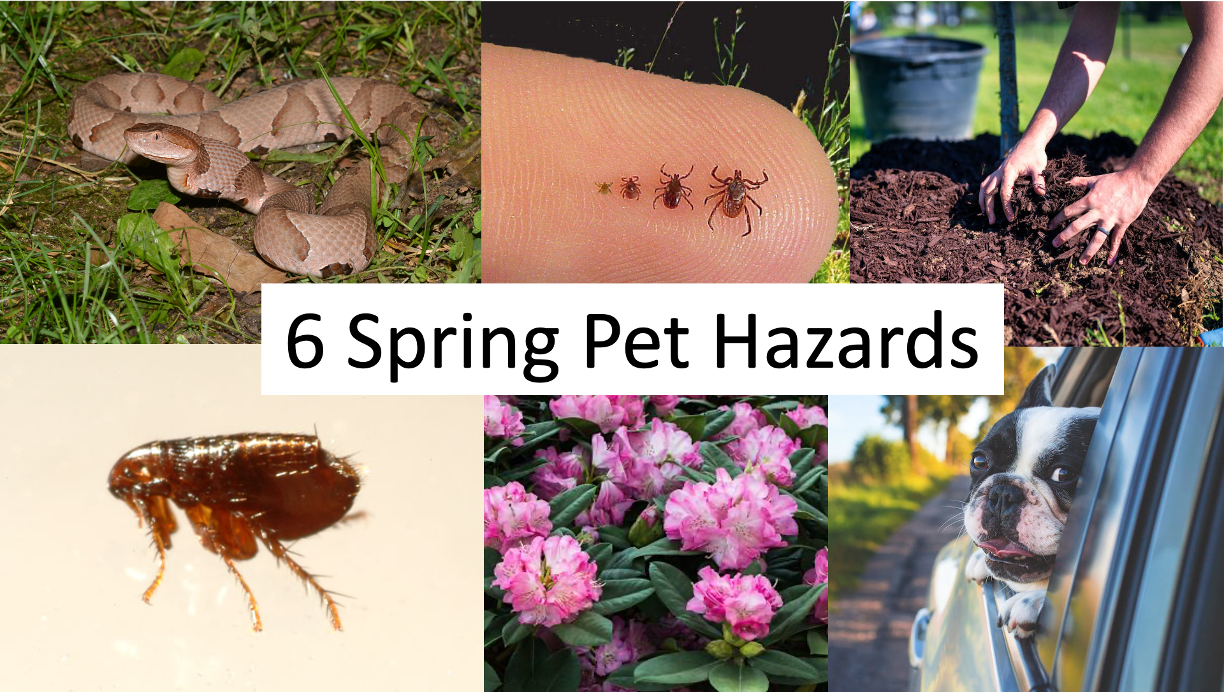
BLOG
Spring Is Near – And So Are Pet Dangers
Merritt Milam | March 1, 2023

Help your pet avoid these springtime hazards.
Punxsutawney Phil may have predicted 6 more weeks of winter, but recent warm weather in our area seems to point to an early spring – and that means hazards for your pet. From flea and tick-borne diseases to toxic plants and snake bite risks, your pet is about to be confronted with several dangers that come with the onset of warmer weather. This month we look at the top 6 springtime dangers that can have your pet spending more time at the vet clinic, than enjoying the beautiful spring weather.
Fleas and Ticks, Oh My!
Whether your pet spends a lot of time outdoors or not, fleas and ticks can still spread several diseases that affect both you and your pet, including skin infections, tapeworms, Lyme disease, Rocky Mountain spotted fever, anaplasmosis, tularemia, and babesiosis.
Taking preventative measures is always recommended as the first line of defense. This involves several products your veterinarian can recommend based on your pet’s lifestyle. Even these may not be 100% effective, but they go a long way towards keeping your pet safe and healthy. Make sure you check your pet after walks outside or playtime at the park. Also, consider yard and home treatments to prevent flea and tick infestation. Regularly washing your pet’s bedding will help keep these pests under control.
Heartworms
Transmitted by a mosquito bite, heartworm disease is a serious and sometimes fatal disease. While heartworms effect the heart and lungs, damage to the liver, kidneys, eyes, and central nervous center can occur. Treatment for an infected pet can be expensive, so regular prevention is strongly recommended to keep your pet safe. Your vet can suggest several options including, monthly, bi-annual, and annual prevention methods.
Snakes
Even if your pet is only outside for a brief walk this spring, beware. Snakes are most active from April through October. Usually, snakes would rather avoid people and pets but if confronted, they do strike. If your pet is bitten, get them to a veterinarian as soon as possible. Antivenom can be given along with fluids and wound care applied to help pets heal. When treated promptly, most dogs will recover quickly.
Fertilizer and Mulch
Getting your yard in shape for spring could be hazardous to your pet’s health if they get into the mulch and fertilizer. According to Pet Poison Helpline, “most fertilizers contain a wide assortment of potentially toxic substances including iron and nitrogen. They could also have pesticides, fungicides, or herbicides. Even if the chemicals don’t poison your pet, large amounts of fertilizer could result in gastrointestinal or pancreatic problems.”
Toxic Plants
In addition to the possible dangers of the fertilizer and mulch in your yard, certain household plants are dangerous to your pet’s health if ingested. Here are just a few that can cause harm or death.
Lilies
Rhododendrons
Tulip bulbs
Azaleas
Amaryllis
English Ivy
Daffodil (especially the bulbs)
Begonia
Chrysanthemum
Hot Car
Dogs normally have a body temperature between 100° and 103° F. When that temperature exceeds 103° it is considered abnormal – above 106° and your pet is in danger of having a heat stroke. Even in the early springtime, a warm day can raise the inside temperature of a car to the danger zone. Never leave your pet in a car alone with no air conditioning. The inside of a hot car can be over 20 degrees hotter than the outside.
We encourage you to make sure your pet has a thorough spring wellness exam and is up to date on their vaccines. Hopefully, these important springtime safety reminders will help you and your pet enjoy the warmer weather and sunnier days ahead.


